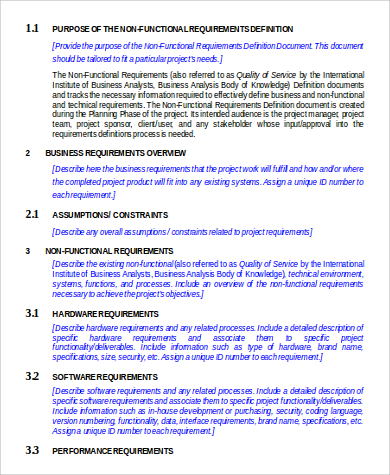

Generic statements used when writing requirements do not always work for NFRs.
#NON FUNCTIONAL REQUIREMENTS HOW TO#
Unaware how to write them or represent them It is much more straight forward to ask, “Tell me what you want the system to do”.ĥ. A question such as, “Tell me how well the system needs to function…” can be challenging for a stakeholder. It can be difficult to interview and capture the NFRs with key stakeholders, as the questions can be quite difficult. It can be hard to identify the stakeholders that business analysts can elicit the requirements from. Not sure how to elicit NFRs and ask the right questions The interpretation of relevance and importance may vary depending on the specific system under consideration, as well as the products and services produced by a business.įor example, organisations in the financial industry - such as insurance, superannuation and banking companies - are likely to view precision, accuracy of information, and access control (security) of confidential information as eminently desired quality attributes.Ĥ. For example: User A might find a 5-second response time acceptable, while User B might define it as a 2-second response time. Inconsistent technology, perplexing explanations, and a lack of common classifications makes the understanding of non-functional requirements difficult.Īn NFR’s key characteristics can be considered, misinterpreted, and evaluated differently from one user to another. Not having a clear understanding of what NFRS are Here are six reasons why NFRs can be missedġ. The key goal of NFRs is to specify HOW the system should do something not WHAT the system should do. What are non-functional requirements?Ī non-functional requirement (NFR) (also referred to as quality attributes or quality of service requirements) is a specification relating to a system’s capabilities and constraints, rather than its functional behavior. I have seen the cost of some projects increase immensely due to the omission of non-functional requirements. We do not want surprises when we think we are about to be done with our project. No matter how much of a hurry you are in we should never FORGET them. We, as professionals, need to make sure they are not omitted and are included during the concept/initiation phases of any project.

#NON FUNCTIONAL REQUIREMENTS SOFTWARE#
Missing, or poorly defined, non-functional requirements can result in the most expensive and difficult changes required on any software development project.


 0 kommentar(er)
0 kommentar(er)
